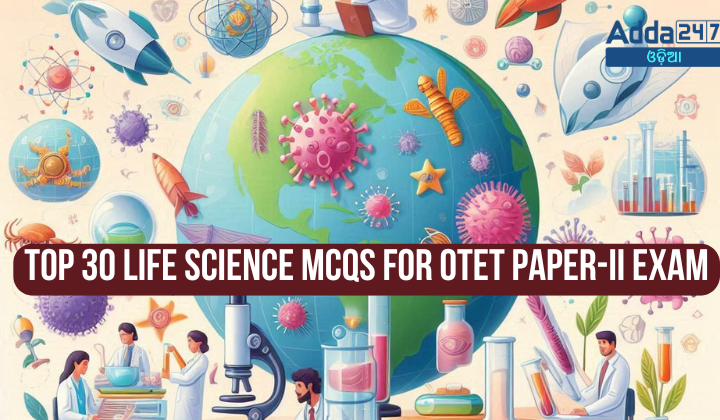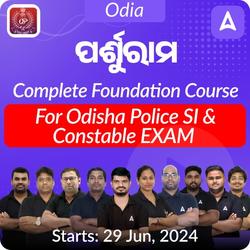Top 30 Life Science MCQS For OTET Paper-II Exam
- Which of the following is an example of structural adaptation in animals?
a) Hibernation
b) Camouflage
c) Migration
d) Sweating
Answer: b) Camouflage - How do cacti adapt to their arid environment?
a) Large leaves
b) Deep roots
c) Spines instead of leaves
d) Thin cuticle
Answer: c) Spines instead of leaves - Which animal is known for its physiological adaptation to survive without water for extended periods?
a) Elephant
b) Camel
c) Dolphin
d) Frog
Answer: b) Camel - The ability of certain animals to blend with their surroundings is called:
a) Mimicry
b) Adaptation
c) Camouflage
d) Migration
Answer: c) Camouflage - What type of adaptation is exhibited by plants growing in salty environments?
a) Halophytes
b) Xerophytes
c) Hydrophytes
d) Mesophytes
Answer: a) Halophytes - Which process in plants is responsible for the uptake of carbon dioxide?
a) Respiration
b) Transpiration
c) Photosynthesis
d) Fermentation
Answer: c) Photosynthesis - The process by which water vapor is lost from the aerial parts of plants is called:
a) Respiration
b) Photosynthesis
c) Transpiration
d) Osmosis
Answer: c) Transpiration - In humans, which gas is primarily exhaled during respiration?
a) Oxygen
b) Nitrogen
c) Carbon Dioxide
d) Hydrogen
Answer: c) Carbon Dioxide - Which organelle is the site of cellular respiration in eukaryotic cells?
a) Nucleus
b) Chloroplast
c) Mitochondrion
d) Ribosome
Answer: c) Mitochondrion - Stomata are involved in:
a) Respiration
b) Photosynthesis
c) Transpiration
d) All of the above
Answer: d) All of the above - Which soil component is primarily responsible for nutrient retention?
a) Sand
b) Clay
c) Silt
d) Gravel
Answer: b) Clay - What is the term for the uppermost layer of soil rich in organic material?
a) Subsoil
b) Bedrock
c) Topsoil
d) Parent material
Answer: c) Topsoil - Deforestation primarily results in:
a) Increased biodiversity
b) Soil erosion
c) Improved air quality
d) Water conservation
Answer: b) Soil erosion - Which type of forest is characterized by a high amount of rainfall and biodiversity?
a) Temperate forest
b) Boreal forest
c) Tropical rainforest
d) Deciduous forest
Answer: c) Tropical rainforest - Humus in soil is important because it:
a) Retains water
b) Adds nutrients
c) Improves soil structure
d) All of the above
Answer: d) All of the above - Which organelle is known as the “powerhouse of the cell”?
a) Nucleus
b) Mitochondrion
c) Endoplasmic Reticulum
d) Golgi Apparatus
Answer: b) Mitochondrion - The site of protein synthesis in the cell is:
a) Nucleus
b) Ribosome
c) Lysosome
d) Chloroplast
Answer: b) Ribosome - Which organelle is involved in the modification and packaging of proteins?
a) Golgi Apparatus
b) Lysosome
c) Endoplasmic Reticulum
d) Vacuole
Answer: a) Golgi Apparatus - Chloroplasts are found in:
a) Animal cells only
b) Plant cells only
c) Both animal and plant cells
d) Fungal cells only
Answer: b) Plant cells only - Which of the following is the function of lysosomes?
a) Protein synthesis
b) Lipid synthesis
c) Digestion of cellular waste
d) ATP production
Answer: c) Digestion of cellular waste - Which micro-organism is responsible for fermentation in bread-making?
a) Bacteria
b) Virus
c) Yeast
d) Algae
Answer: c) Yeast - Which disease is caused by a bacterium?
a) Influenza
b) Tuberculosis
c) Malaria
d) HIV/AIDS
Answer: b) Tuberculosis - Antibiotics are used to treat infections caused by:
a) Viruses
b) Bacteria
c) Fungi
d) Protozoa
Answer: b) Bacteria - Penicillin, the first antibiotic, is derived from:
a) Bacteria
b) Algae
c) Fungi
d) Protozoa
Answer: c) Fungi - Which of the following micro-organisms can be used in bioremediation to clean up oil spills?
a) Viruses
b) Yeast
c) Bacteria
d) Protozoa
Answer: c) Bacteria - Which gland is responsible for the production of hormones during puberty?
a) Thyroid gland
b) Adrenal gland
c) Pituitary gland
d) Pancreas
Answer: c) Pituitary gland - During adolescence, the body undergoes significant changes primarily due to:
a) Increase in metabolic rate
b) Growth spurts
c) Hormonal changes
d) All of the above
Answer: d) All of the above - The period of rapid physical growth and sexual maturation in adolescence is known as:
a) Menopause
b) Infancy
c) Puberty
d) Senescence
Answer: c) Puberty - Which of the following is a common psychological change during adolescence?
a) Increased dependence on parents
b) Decreased emotional sensitivity
c) Development of identity
d) Reduced cognitive abilities
Answer: c) Development of identity - Menarche is the term used to describe:
a) The onset of puberty in boys
b) The first menstrual period in girls
c) The end of adolescence
d) None of the above
Answer: b) The first menstrual period in girls










